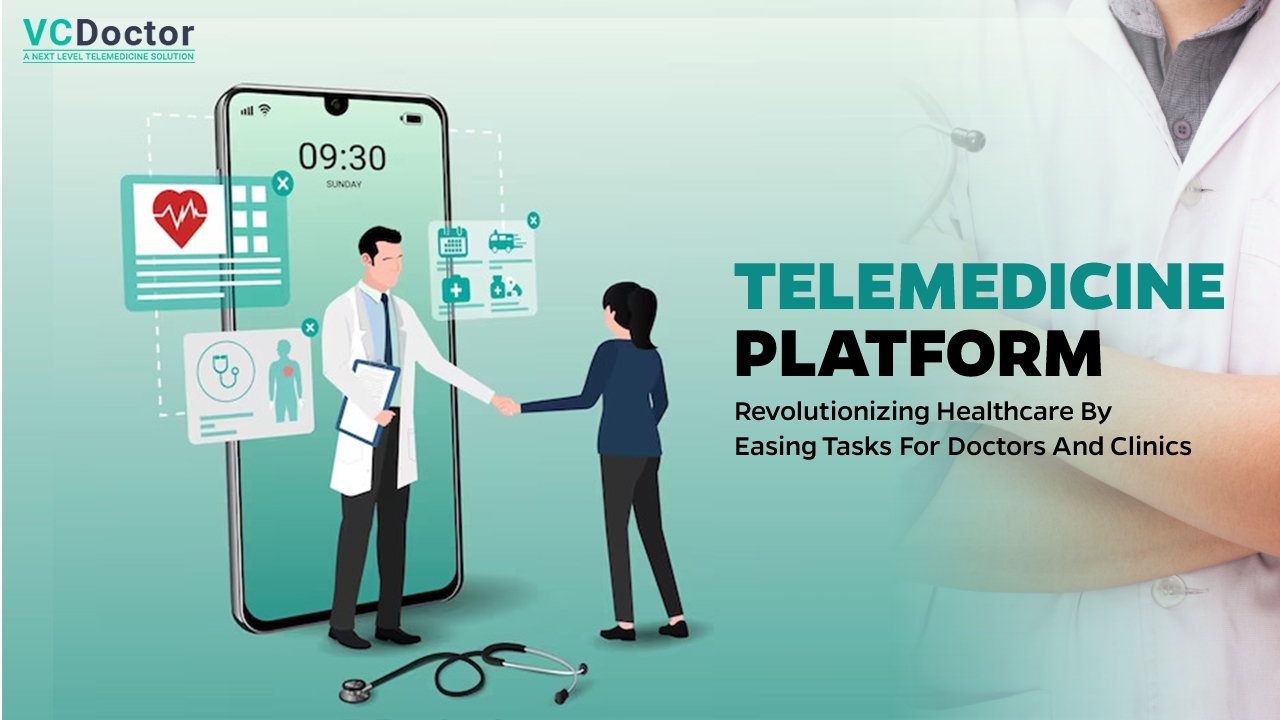Telemedicine Platform – Revolutionizing Healthcare by Easing Tasks for Doctors and Clinics
In the digital age, technology has revolutionized numerous industries and healthcare is no exception. Healthcare technology has managed to grab considerable attention in recent years with the latest innovations emerging every year. Telemedicine is one such technological advancement that has undoubtedly revolutionized the healthcare sector, as it is playing a significant role in improving provider-patient interaction. Telemedicine, the provision of healthcare services remotely using telecommunications technology, has emerged as a game-changer for clinics and medical practitioners alike. It connects patients with healthcare providers, enabling virtual consultations, diagnosis, treatment, and monitoring of medical conditions. A telemedicine platform allows secure and HIPAA-compliant virtual medical consultations through video conference. This platform is greatly used by doctors, clinics, and telemedicine providers for interacting with patients and other providers. A highly innovative, scalable, and flexible telemedicine platform is effective in driving clinical quality.
Advantages of Telemedicine Platform
The Telemedicine platform offers numerous benefits, from increasing the accessibility of health care, easing follow-up consultations, better health monitoring, and facilitating chronic health management to improving better health outcomes. According to HIMSS Analytics, over 70% of healthcare providers are using telemedicine platforms to connect with their patients. With the greater adoption of this platform by doctors and clinics, this technology is no more confined to video-based consultations. An area that has immensely benefitted from it is remote patient monitoring. Let’s dive deeper to explore the advantages and significance of telemedicine platforms for clinics and doctors, showcasing how this transformative technology is reshaping the way healthcare is delivered.
Access to Healthcare beyond Borders
One of the most significant advantages of telemedicine platforms is their ability to break down geographical barriers. This facility has allowed doctors to reach a broader audience, providing care to individuals who may otherwise be unable to receive timely medical attention. Now expert doctors or specialists can also get in touch with patients residing in remote areas using the telemedicine platform. With the rising cases of chronic diseases, the telemedicine platform has allowed healthcare providers to track and manage their patient’s health at home.
Streamlining Healthcare Delivery
Telemedicine platforms streamline healthcare delivery by optimizing appointment scheduling and reducing waiting times. Doctors can efficiently manage their patient load, conduct virtual consultations, and provide follow-up care. The platforms often integrate with electronic health records (EHR) systems, ensuring seamless access to patient histories, test results, and treatment plans, further enhancing the quality of care provided.
Virtual Consultations
Telemedicine platforms allow healthcare providers to provide video or audio consultations to patients. Patients can discuss their symptoms, receive medical advice, and even get prescriptions issued remotely. It helps healthcare professionals provide virtual consultations without having to travel anywhere.
Enhanced Patient Engagement
Telemedicine platforms foster improved patient engagement through enhanced communication channels. Doctors can easily connect with patients, providing real-time answers to their queries and concerns. This continuous interaction promotes a stronger doctor-patient relationship, leading to better patient adherence to treatment plans and improved health outcomes.
Better Work-life Balance for Healthcare Providers
Besides, health management benefits healthcare providers and doctors also enjoy a better work-life balance with the telemedicine platform. Doctors make use of this platform to reduce the commute time that they spend to see patients which gives them more time to spend with friends or family. Doctors also make use of this platform to efficiently manage their time without compromising on their patient care.
Cost-Effectiveness and Time Efficiency
For both clinics and patients, telemedicine platforms offer cost-effective alternatives to traditional in-person consultations. Clinics can save on administrative costs, office space, and staff time, while patients can avoid expenses related to transportation and childcare. Moreover, telemedicine allows doctors to see more patients within a given time frame, optimizing their time and productivity.
Control of Infectious Diseases
Telemedicine platform is also effective in preventing the spread of flu and other infectious diseases, as doctors can use telehealth appointment to prescreen patients for possible infections. It prevents sick people from coming to clinics, thereby restricting the spread of infectious diseases. Telemedicine effectively reduces infection risks and allows doctors to diagnose their patients from a safe location.
Remote Monitoring and Chronic Disease Management
Telemedicine platforms facilitate remote monitoring of patients with chronic conditions. Doctors can track vital signs, review symptoms, and adjust treatment plans as needed. This continuous monitoring empowers patients to take a proactive approach to managing their health, leading to better disease management and a reduced number of hospital read missions.
Flexibility for Healthcare Professionals
Telemedicine platforms offer flexibility to doctors by enabling them to provide medical services from the comfort of their homes or other remote locations. This can be especially beneficial for healthcare practitioners with family responsibilities or those seeking to maintain a work-life balance. Additionally, telemedicine opens up opportunities for specialists to reach a wider patient base without relocating to different cities or regions.
Easing the Burden on Emergency Departments
By offering an alternative to in-person visits, telemedicine platforms help reduce the strain on emergency departments. Non-emergency cases can be handled efficiently through virtual consultations, allowing emergency rooms to focus on critical cases and urgent medical needs.
Reduces Potential Errors in Medical Practice
For effective healthcare delivery, it is vital to efficiently manage clinician workload and their task management. If doctors and clinicians have a high workload and they find extreme difficulty in juggling their daily tasks, then this may lead to errors in medical practice.
Reduce Clinics Overhead Cost
Clinics will be able to reduce their overhead cost by moving to a telemedicine platform. Clinics will have the option to rent a smaller space for clinics at a lower rent and will also not require recruiting several front desk representatives, as a limited number of patients will be visiting clinics. This will help them save huge upfront costs.
Conclusion
Telemedicine platforms have emerged as a transformative force in healthcare, benefiting both clinics and doctors while revolutionizing patient care. With enhanced accessibility, streamlined healthcare delivery, cost-effectiveness, and improved patient engagement, telemedicine is reshaping the way healthcare services are provided. As technology continues to advance, telemedicine will play an increasingly pivotal role in expanding the reach of medical services and improving the overall quality of patient care. Embracing this technological evolution is essential for clinics and doctors to stay at the forefront of healthcare innovation and provide the best possible care to their patients.
FAQ
What are telehealth platforms?
Telehealth platforms are digital systems that facilitate remote healthcare services either through web-based or mobile-based applications. It allows patients and healthcare providers to connect virtually for consultations, diagnoses, and treatment.
What are two types of telemedicine?
Two types of telemedicine are:
Synchronous Telemedicine – This involves real-time communication between patients and healthcare providers through video conferencing, phone calls, or live chat consultations.
Asynchronous Telemedicine – This type involves the exchange of medical information between patients and providers without real-time interaction through images, test results, or messages.
What is the largest telehealth platform?
VCDoctor is a highly trusted and HIPAA-compliant telehealth platform that brings doctors and patients together on a single platform. It is one of the largest telehealth platforms that are used by clinics, hospitals, and telemedicine businesses in over 16 countries.
What devices are used in telemedicine?
The primary device used in telemedicine is a computer or a smartphone. These devices allow patients and healthcare providers to connect virtually through video conferencing or messaging platforms. Besides these, specialized medical devices like digital stethoscopes, otoscopes, and high-resolution cameras can be used for remote examinations.
What is the most common type of telemedicine?
The most common type of telemedicine is synchronous telemedicine, which involves real-time communication between patients and healthcare providers. This method typically utilizes video conferencing platforms or phone calls, allowing for immediate interaction and consultation.
Which is the best telemedicine software?
Currently, there are some world-recognized telemedicine software options but the name that immediately comes to mind is the VCDoctor. It is a white-label telemedicine solution facilitating easy and quick consultation from anywhere.
Who uses telemedicine the most?
Telemedicine usage has increased across all demographics because of its ability to provide healthcare services while reducing the risk of virus transmission and minimizing physical contact. Telemedicine is also increasingly used by individuals in rural or remote areas, who face limited access to healthcare facilities, as they have found telemedicine particularly beneficial.
What is mobile telemedicine system?
A mobile telemedicine system is a digital healthcare platform that enables remote medical consultations and services through mobile devices, such as smartphones or tablets. This system allows patients to connect with healthcare providers via video calls, secure messaging, or other communication tools.




